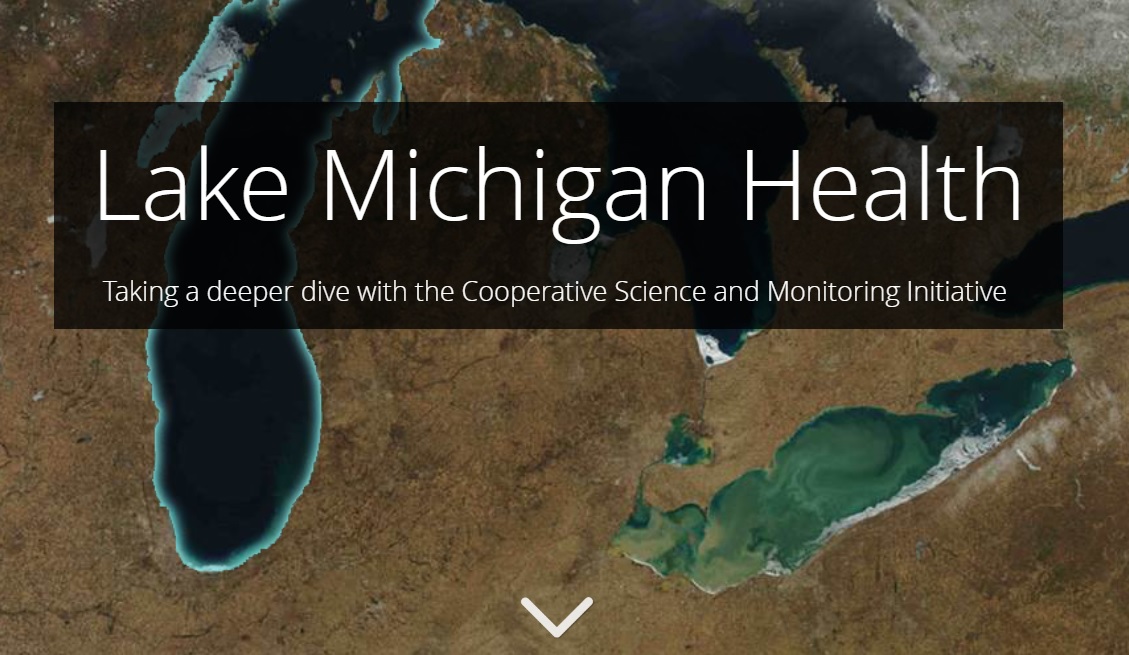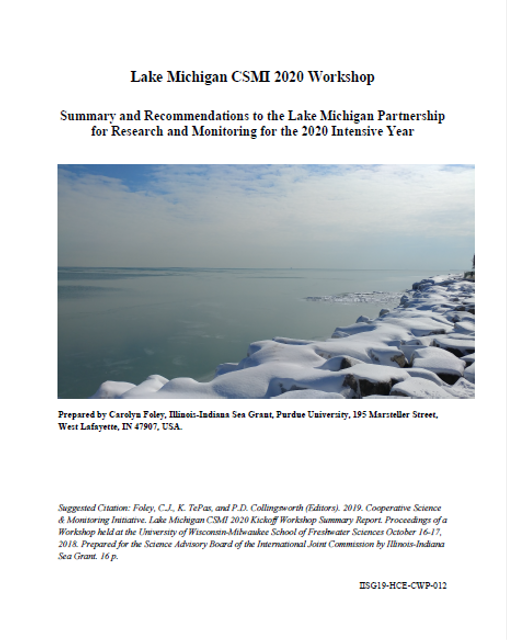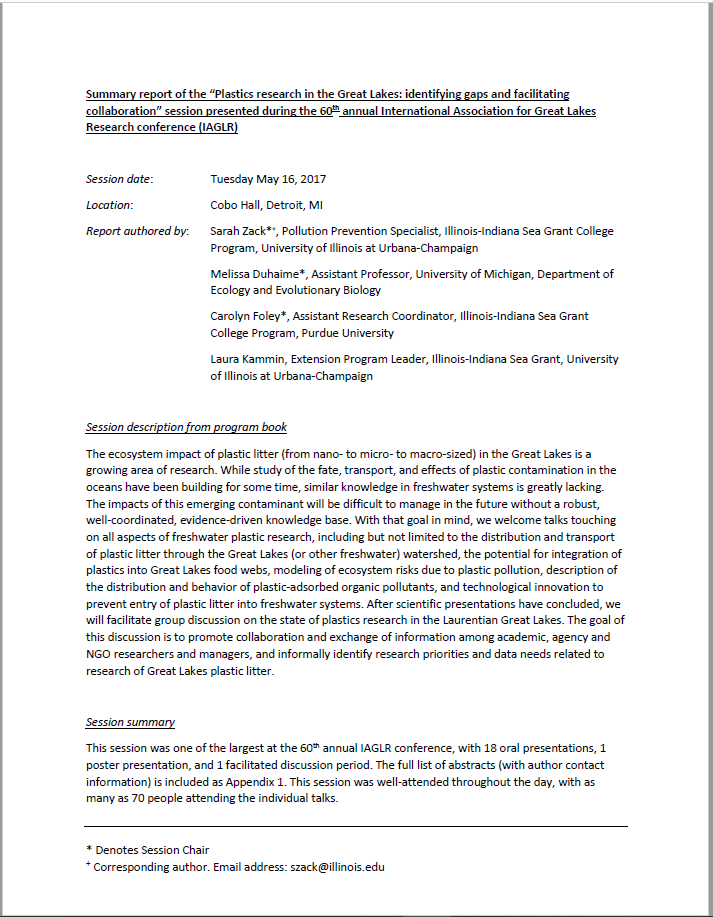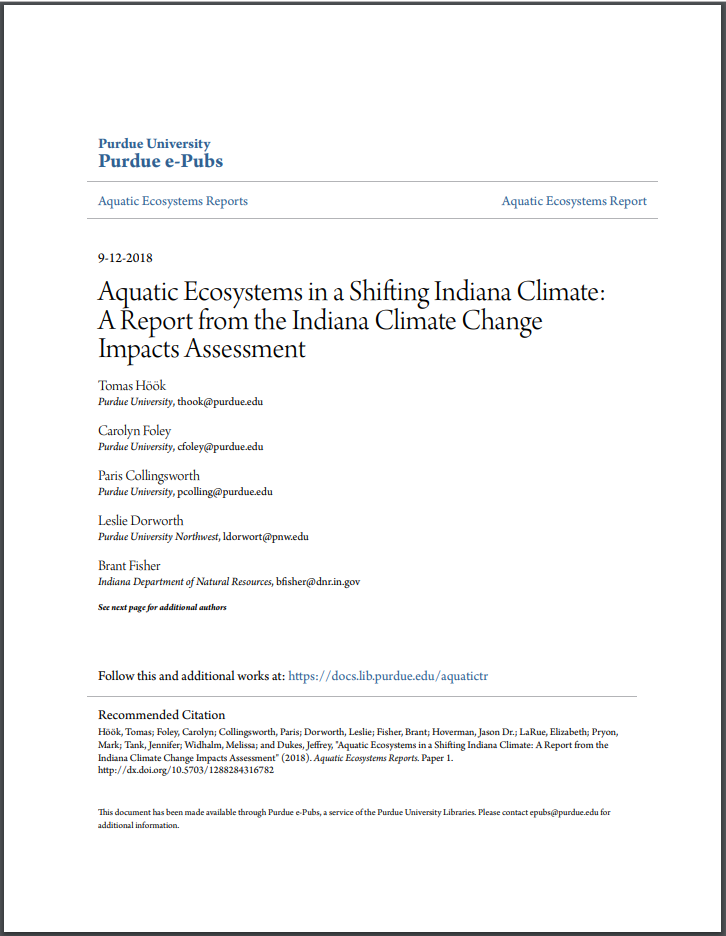Results
Year: 2019
This story map relays key findings from the 2015 Lake Michigan field year of the Cooperative Science and Monitoring Initiative. This digital, multi-media outreach tool is intended to convey research results to broad audiences including anglers, boaters, conservation groups, and other Lake Michigan stakeholders.
For more detailed information, visit Lake Michigan Health: A Deeper Dive
File Type: pdf
File Size: 618.04 KB
Year: 2019
On October 16 and 17, 2018, nearly 60 scientists and managers met at a workshop in Milwaukee, WI to discuss research needs for Lake Michigan. The workshop, sponsored by the International Joint Commission through its Science Advisory Board Research Coordination Committee and organized by Illinois-Indiana Sea Grant, was part of the Cooperative Science Monitoring Initiative (CSMI). The main purpose of the meeting was to kick off discussions about research priorities to be considered during the 2020 CSMI intensive field year on Lake Michigan. This document summarizes the meeting proceedings.
Download File

File Type: pdf
File Size: 7.78 MB
Year: 2018
The role of the Cooperative Science and Monitoring Initiative (CSMI) is to provide enhanced monitoring and research activities that provide relevant information to address the science priorities of the Lake Partnerships (established under the Lakewide Management Annex of the 2012 Great Lakes Water Quality Agreement) across the Laurentian Great Lakes. The Lake Michigan Partnership, a collaborative team of natural resource managers led by the U.S. Environmental Protection Agency with participation from federal, state, tribal, and local governments or agencies, uses the information collected through CSMI to help develop long term ecosystem-based management strategies for protecting and restoring Lake Michigan’s water quality. On a practical level, CSMI is an intensive effort to collect information on the health of each lake, rotating to one Great Lake each year. In 2015, it was Lake Michigan’s turn. This is an executive summary of the 2015 research results and the associated white paper containing more specific information.
Download File
File Type: pdf
File Size: 266.39 KB
Year: 2017
This session was one of the largest at the 60th annual IAGLR conference, with 18 oral presentations, 1 poster presentation, and 1 facilitated discussion period. The full list of abstracts (with author contact information) is included as Appendix 1. This session was well-attended throughout the day, with as many as 70 people attending the individual talks.
Download File

Year: 2019
Ecological complexity may improve ecosystem function, stability and adaptability to natural and anthropogenic disturbances. Intraspecific trophic variation can represent a significant component of total community variation and can influence food web structure and function. Thus, understanding how trophic niches are partitioned between intraspecific and interspecific processes could improve our understanding of food web dynamics.
We examined gut contents, fatty acids and stable isotope ratios in round goby (Neogobius melanostomus) and yellow perch (Perca flavescens) across six sites in Lake Michigan, USA, to determine patterns in intra‐ and interspecific trophic composition (i.e., mean gut or fatty acid composition) and diversity (i.e., the diversity of gut items or fatty acids). We also examined relationships between fatty acid diversity and gut content characteristics to understand potential mechanisms shaping individual trophic phenotypes. There was significant variation in both trophic composition and diversity among sites, and individual and spatial variation was as important to total trophic variation as species identity. Round goby that consumed dreissenid mussels had more diverse fatty acid profiles than those that consumed other benthic invertebrates, whereas yellow perch fatty acid diversity was not related to gut content composition. Our results confirm that intraspecific variation in resource use can be as important to trophic dynamics as interspecific variation, and that spatial variation in lower level food web processes or habitat may strongly structure local food web dynamics. Individual‐level examination of trophic diversity, in concert with trophic composition, could provide additional information about the resilience, function and adaptability of local food webs.
Document available through publisher’s website: 10.1111/eff.12472
Year: 2018
Indiana’s ecosystems will experience changes in water quantity, water temperature, ice cover, water clarity, and oxygen content as the state’s temperature and rainfall patterns shift. The plants and animals living in these aquatic ecosystems will undergo changes that will vary based on the species and the specific places they inhabit.
Part of the Indiana Climate Change Impacts Assessment (IN CCIA).
Download the report from Purdue e-Pubs. DOI: 10.5703/1288284316782
Page 2 of 3
Note: Some older Illinois-Indiana Sea Grant publications have not yet been restructured into ADA compliant formats. We are actively working on this. If you are having difficulty accessing a particular item in one of our databases, please contact iisg@purdue.edu with the name of the item and its URL for further assistance.






